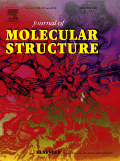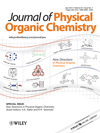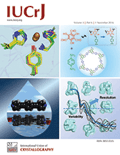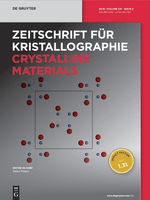
JOURNAL OF CHEMICAL CRYSTALLOGRAPHY
Scope & Guideline
Unlocking the secrets of chemical crystallography since 1994.
Introduction
Aims and Scopes
- Synthesis of Coordination Compounds:
The journal frequently publishes articles on the synthesis of various coordination compounds, particularly those involving transition metals and organic ligands, highlighting new synthetic routes and methodologies. - Crystal Structure Analysis:
A core focus is the detailed analysis of crystal structures using techniques such as X-ray diffraction, which helps elucidate the arrangement of atoms in crystalline solids. - Spectroscopy and Computational Studies:
Many papers incorporate spectroscopic methods (IR, NMR) and computational approaches (DFT) to complement structural data, providing insights into molecular interactions and properties. - Supramolecular Chemistry:
Research on supramolecular assemblies and interactions, including hydrogen bonding and π-π stacking, is a significant area of interest, reflecting the journal's commitment to exploring complex molecular architectures. - Biological and Functional Properties:
The journal also addresses the biological implications of crystalline materials, including studies on DNA binding, antimicrobial activity, and other functional properties.
Trending and Emerging
- Metal-Organic Frameworks (MOFs):
There is a notable increase in publications focusing on the synthesis and characterization of metal-organic frameworks, highlighting their potential applications in gas storage, catalysis, and drug delivery. - Hirshfeld Surface Analysis:
The use of Hirshfeld surface analysis is gaining traction, providing detailed insights into molecular packing and interactions, which is increasingly recognized as a valuable tool in crystallography. - Polymorphism Studies:
Research on polymorphism, particularly in pharmaceutical compounds, is on the rise, reflecting the growing importance of understanding different crystalline forms in drug development. - Sustainable and Green Chemistry:
An emerging focus on sustainable practices in synthesis and characterization, including solvent-free methods and eco-friendly materials, aligns with global trends towards sustainability in chemistry. - Nanocrystalline Materials:
The investigation of nanocrystalline materials and their unique properties is becoming more prominent, indicating a shift towards exploring materials at the nanoscale for various applications.
Declining or Waning
- Organometallic Chemistry:
Research specifically centered on organometallic compounds has seen a decrease, possibly due to the broader integration of these compounds into more complex coordination and supramolecular chemistry studies. - Theoretical Predictions Without Experimental Validation:
There is a waning interest in purely theoretical studies that lack experimental validation, as the journal increasingly favors comprehensive studies that combine theoretical predictions with experimental data. - Traditional Ligand Systems:
The use of conventional ligand systems in coordination chemistry appears to be declining, with a shift towards more innovative and multifunctional ligands that enhance structural diversity and functionality.
Similar Journals

Molbank is an open-access journal published by MDPI, dedicated to the fields of Biochemistry, Organic Chemistry, and Physical and Theoretical Chemistry. Established in 2002, this journal has served as a vital platform for the dissemination of research findings, where researchers and professionals share original articles focusing on molecular chemistry, synthesis, and related studies. With a commitment to open access, Molbank enables global access to scientific knowledge, fostering collaboration and innovation among scientists. While currently categorized in the fourth quartile for its field rankings, it provides a unique opportunity for emerging scholars to contribute to and engage with the scientific community. The journal is based in Switzerland, operating from its office at ST ALBAN-ANLAGE 66, CH-4052 BASEL, SWITZERLAND, and continues to attract submissions until 2024. Researchers, students, and professionals looking to expand their knowledge and participate in the dialogue of current molecular chemistry can benefit significantly from engaging with the content published in Molbank.

Journal of Molecular Structure
Advancing molecular insights for a dynamic future.Journal of Molecular Structure is a premier publication in the field of chemistry, offering a platform for innovative research that spans analytical, inorganic, organic chemistry, and spectroscopy. Published by Elsevier in the Netherlands, this journal is committed to advancing the understanding of molecular architecture and behavior through high-quality, peer-reviewed articles. With its impressive impact factor and a notable Scopus ranking placing it in the top quartiles among its peers, it serves as an essential resource for researchers, professionals, and students alike. The journal's open access options promote the dissemination of knowledge, ensuring that groundbreaking discoveries reach a broad audience. Established in 1967 and projected to continue through 2025, the Journal of Molecular Structure is vital for anyone engaged in the study of molecular interactions and structural analysis.

JOURNAL OF PHYSICAL ORGANIC CHEMISTRY
Unveiling the principles behind organic processes.JOURNAL OF PHYSICAL ORGANIC CHEMISTRY, published by Wiley, serves as a vital platform for researchers and professionals in the fields of organic and physical theoretical chemistry. With a rich history of publication dating back to 1988 and continuing through 2024, this esteemed journal aims to advance the understanding of the physical principles underlying organic reactions and processes. Although it operates without an open access model, the journal maintains a respectable impact factor and has achieved Q3 rankings in both Organic Chemistry and Physical and Theoretical Chemistry as of 2023, affirming its relevance within the scientific community. Researchers looking to publish innovative studies will find a competitive space given its Scopus rankings—placed at #105 in Physical and Theoretical Chemistry and #123 in Organic Chemistry. The journal not only curates high-quality research but also encourages collaboration and the exchange of ideas, making it a cornerstone for anyone dedicated to exploring the complexities of organic materials and their physical interactions.

Results in Chemistry
Bridging Knowledge and Accessibility in ChemistryResults in Chemistry is a prominent journal published by Elsevier, dedicated to fostering innovation and disseminating cutting-edge research in the field of chemistry. With an ISSN of 2211-7156, this open-access journal has been committed to making scientific knowledge widely available since 2019, aligning with the global trend towards accessibility in research. Based in the Netherlands, it features interdisciplinary studies that span the breadth of general chemistry, contributing significantly to the academic dialogue within the scientific community. Despite currently holding a Q3 ranking in the miscellaneous category of chemistry and occupying the 228th position out of 408 in Scopus rankings, the journal is poised for growth, aiming to enhance its impact and visibility. Researchers, professionals, and students alike will find invaluable resources and insights within its pages, making Results in Chemistry an essential platform for those looking to stay abreast of advancements and trends in chemistry research up to the year 2024.

IUCrJ
Elevating Research Standards in Chemistry and PhysicsIUCrJ, published by the International Union of Crystallography, is a leading open-access journal dedicated to advancing knowledge in the fields of Biochemistry, Chemistry, Condensed Matter Physics, and Materials Science. Since its inception in 2014, IUCrJ has quickly established itself as a prestigious platform for high-quality research, achieving a remarkable record as a Q1 journal across its categories in 2023. With an increasing impact in the scientific community, evidenced by impressive Scopus rankings, IUCrJ offers unparalleled access to groundbreaking discoveries and methodologies that contribute to the understanding and application of crystallography in various disciplines. The journal’s commitment to open access ensures that research is readily available to a global audience, fostering collaboration and innovation in the scientific community. IUCrJ is an essential resource for researchers, professionals, and students aiming to stay at the forefront of crystallographic research and its interdisciplinary applications.

RUSSIAN JOURNAL OF INORGANIC CHEMISTRY
Unveiling Innovations in Materials ChemistryThe Russian Journal of Inorganic Chemistry is a distinguished publication that delves into the fundamental and applied aspects of inorganic chemistry. Published by MAIK Nauka/Interperiodica/Springer, this journal has established itself as a vital resource for researchers, professionals, and students alike, contributing significantly to the fields of Inorganic Chemistry, Materials Science, and Physical and Theoretical Chemistry. With an ISSN of 0036-0236 and an E-ISSN of 1531-8613, the journal is indexed for easy access and citation. Though the journal currently operates under a subscription model, its commitment to disseminating high-quality research and fostering scientific discourse remains steadfast. The journal has been maintaining a consistent record since its inception, and its positioning in the Q3 quartile across various chemistry categories in 2023 underscores its relevance in the academic community. As it continues through its converged years from 1996 to 2024, the Russian Journal of Inorganic Chemistry plays a pivotal role in enhancing the understanding and advancement of inorganic chemistry, making it an indispensable tool for anyone engaged in this dynamic field.

Zeitschrift fur Kristallographie-Crystalline Materials
Pioneering Research in the World of CrystallographyZeitschrift für Kristallographie-Crystalline Materials is a prestigious academic journal published by Walter de Gruyter GmbH, focusing on the intricate field of crystallography and its applications within condensed matter physics, inorganic chemistry, and materials science. Established in Germany, this journal spans a rich history from its inception in 1930 to its convergence years from 2012 to 2024, presenting cutting-edge research and developments in crystalline materials. With an impact factor reflective of its critical role within its field—ranking Q3 in the prestigious quartiles for 2023 across multiple categories—this journal serves as an essential platform for researchers, professionals, and students seeking to expand their knowledge and contribute to the advancement of crystalline materials. While currently not offering open access, the journal remains committed to disseminating high-quality, peer-reviewed articles that inspire innovation and collaboration within the scientific community.

DOKLADY CHEMISTRY
Fostering academic excellence in chemical sciences.DOKLADY CHEMISTRY is an esteemed academic journal published by MAIK NAUKA/INTERPERIODICA/SPRINGER, focusing on the dynamic field of chemistry. Established in 1996, this journal serves as a significant platform for disseminating cutting-edge research, reviews, and significant developments in various areas of chemistry, including but not limited to general and miscellaneous chemistry. Currently indexed with an ISSN of 0012-5008 and E-ISSN of 1608-3113, DOKLADY CHEMISTRY maintains a commitment to academic rigor and integrity, contributing critical insights to the scientific community. Despite its Q4 ranking in the 2023 Chemistry category and a Scopus rank of #314 out of 408, this journal remains an important resource for researchers, professionals, and students eager to explore emerging trends and innovative methodologies in the field. The journal operates under a model that supports comprehensive scholarly communication, making it a key fixture among established chemistry publications.

CRYSTALLOGRAPHY REPORTS
Bridging Disciplines with Crystallographic InsightsCRYSTALLOGRAPHY REPORTS (ISSN: 1063-7745, E-ISSN: 1562-689X), published by PLEIADES PUBLISHING INC, is a pivotal journal in the fields of chemistry, condensed matter physics, and materials science. Established in 1996 and continuing through to 2024, it serves as a vital resource for researchers and professionals seeking to disseminate and engage with contemporary advancements in crystallography. While currently not classified as open access, the journal's rigorous peer-review process ensures the publication of high-quality research, making it a respected entity within the academic community. With a categorization in the Q4 quartile for its respective fields and notable Scopus rankings, CRYSTALLOGRAPHY REPORTS is committed to fostering an understanding of crystallographic techniques and their application across scientific disciplines. This journal is essential for those looking to stay abreast of the latest findings and methodologies in crystallography, providing a platform for impactful discussions and collaborations.

INDIAN JOURNAL OF CHEMISTRY
Breaking Barriers in Chemistry Research for AllINDIAN JOURNAL OF CHEMISTRY, published by the NATL INST SCIENCE COMMUNICATION & POLICY RESEARCH (NIScPR), stands as a vital platform for disseminating innovative research and advancements in the fields of organic, inorganic, and physical chemistry. With its inception in 1969, this journal has served the global community of chemists and researchers, contributing significantly to the advancement of chemical sciences in India and beyond. The journal maintains a strong commitment to open access, facilitating widespread dissemination of knowledge, allowing readers from diverse backgrounds to access cutting-edge research without barriers. Although coverage in Scopus has been temporarily discontinued, the journal continues to uphold rigorous scholarly standards, making it an authoritative source for academicians, professionals, and students alike. Readers can expect high-quality articles that reflect the latest developments and discoveries in chemistry, reinforcing the journal's reputation as an essential resource in the scientific community.